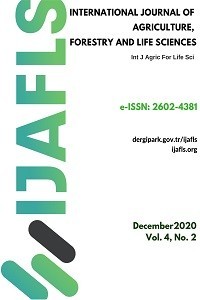Effects of Donor Plant Age and Explant Types on Asparagus (Asparagus officinalis L.) Micropropagation
Effects of Donor Plant Age and Explant Types on Asparagus (Asparagus officinalis L.) Micropropagation
Asparagus officinalis, micropropagation, donor age shoot tip, axillary bud,
___
- Açıkgöz, N., İlker, E., Gökçöl, A., 2004, Biyolojik Araştırmaların Bilgisayarda Değerlendirilmeleri, Ege Üniversitesi Tohum Teknolojisi Uyg. Ve Araş. Merkezi Yayınları No:2, Ege Üniversitesi Ziraat Fakültesi Ofset Atölyesi, Bornova-İzmir, 202s.
- Altunel, T. A. 2021, Morphological and Habitat Characteristics of Asparagus (Asparagus officinalis L.) and Socio-Economic Structure of Producers. Turkish Journal of Agriculture-Food Science and Technology, 9(6), 1092-1099.
- Anderson, T.W., 1984, An Introduction to Multivariate Statistical Analysis, Second Edition, John Wiley and Sons.
- Azad, M.A.K., Amin, M.N., 2017, Regeneration of Asparagus officinalis L. Through Embriyogenic Callus. Plant Tissue Culture and Biotech. 27(1): 21-31.
- Bojnauth, G., Puchooa, S., Bahorun, T., 2003, In vitro Regeneration of Asparagus officinalis: preliminary results. Food and Agriculture Research Council, Reduit, Mauritius, AMAS, pp. 7–15.
- Conner, A.J., Abernethy, D.J., Falloon, P.G., 1992, Importance of in vitro storage root development for the successful transfer of micropropagated asparagus plants to greenhouse conditions, New Zealand Journal of Crop and Horticultural Science, 20:4, 477-481.
- Culpupper, C.W., Moon, H.H., 1939, Changes in the composition and rate of growth along the developing stem of asparagus. Plant Physiology, 14:677-698.
- Desjardins, Y., 1992, Micropropagation of Asparagus (Asparagus officinalis L.). In: Bajaj Y.P.S. (eds) High-Tech and Micropropagation III. Biotechnology in Agriculture and Forestry, vol 19. Springer, Berlin, Heidelberg.
- Fortes, G., Muller, N., Augustin, E., Silva, J., Peters, J., Flores, R., 1997, The Influence of Spear Number on in vitro Rooting of Asparagus (Asparagus officinalis L.). HortScience. 32 (3), 471.
- Harada, T., Yakuwa, T., 1983, Studies on The Morphogenesis of Asparagus : Ⅵ. Effect of Sugar on Callus and Organ Formation in The in vitro Culture of Shoot Segments of The Seedlings. Journal of the Faculty of Agriculture, Hokkaido University, 61(3), 307-314.
- Inagaki, N., Harada, T., Yakuwa, T., 1981, Studies on The Anther Culture of Horticultural Crops: IV. Effect of Growth Regulators on Organ Formation From Anther Derived Callus of Asparagus officinalis L. J. Faculty Agric., Hokkaido University. 60 (3), 236–249.
- Khunachak, A., Chin, C., Le, T., Gianfagna, T., 1987, Promotion of asparagus shoot and root growth by growth retardants. Plant Cell, Tissue and Organ Culture. 11, 97–110.
- Kubota, S., Konno, I., Kanno, A., 2012, Molecular phylogeny of the genus Asparagus (Asparagaceae) explains interspecific crossability between the garden asparagus (A. officinalis) and other Asparagus species, Theor Appl Genet, 124, 345–354.
- Levi, A., Sink, K.C., 1991, Somatic Embryogenesis in Asparagus: The Role of Explants and Growth Regulators. Plant Cell Reports, 10:71-75.
- Maung, M., Myint, K.T., Thu, M.K., 2019, Effects of Different Explant Types, Plant Growth Regulators and Shoot Density on in vitro Regeneration of Asparagus (Asparagus officinalis L.). Journal of Agricultural Research, Vol. 6 (1), 109-115.
- Rasad, F. M., Hasbullah, N. A., Azis, N. A., Daud, N. F., Lassim, M. M., 2019, Micropropagation of Asparagus officinalis L. (Garden Asparagus) In Vitro.
- Paudel, N., Aryal, M.R., Puri, R.H., 2018, Effect of hormone for in vitro propagation of Asparagus racemosus Wild. Current Life Sciences, 4(4), 53-61.
- Pontaroli, A.C., Camadro, E.L., 2005, Plant Regeneration After Long Term Callus Culture in Clones of Asparagus officinalis L. Biocell. 29 (3), 313–317.
- Sallam, A.S., 2019, In vitro Propagation of F1 Male Hybrid Lines in Asparagus officinalis.Egyptian J. Desert Res., 69, No.1, 67-86.
- Sarabi, B., Almasi, K., 2010, Indirect organogenesis is useful for propagation of Iranian edible wild Asparagus (Asparagus officinalis L.). Asian Journal of Agricultural Sciences, 2(2), 47-50.
- Slabbert, M.M., Lindeque, J.M., Ferreira, D.I., 1990, Rapid in vitro multiplication of Asparagus. South African Journal of Botany, 56(3), 331-335.
- Yayın Aralığı: Yılda 2 Sayı
- Başlangıç: 2017
- Yayıncı: Volkan OKATAN
Hatice Büşra YAVUZ, Nuray ÇÖMLEKÇİOĞLU
Hatice BAŞ, Halil Erhan EROĞLU, Hülya DOĞAN, Tansu USKUTOĞLU, Belgin COŞGE ŞENKAL, Cuneyt CESUR
Some fruit quality characteristics of ‘Grand Naine’ banana fruits during various ripening stages
Ömer Faruk BİLGİN, Gözde NOGAY, Ebruyasakafkas@gmail.com KAFKAS, Salih KAFKAS
